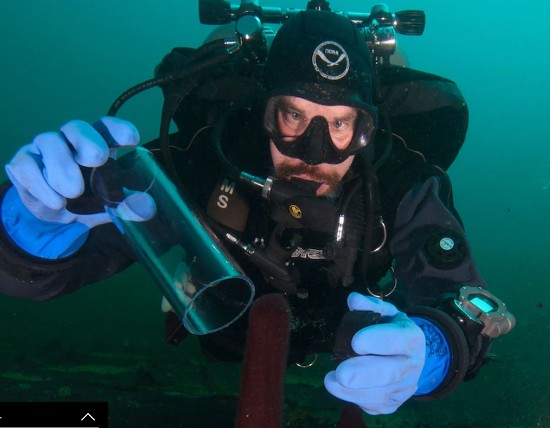If Earth were like the Moon which presents the same face to us when we see it in the night sky, a physical phenomenon called tidal lock, it is unlikely that the planet would have seen complex life emerge. So states an article appearing in Nature Geoscience written by Judith Klatt, at Bremen, Germany’s Max Planck Institute for Marine Microbiology, with co-authors A. Chennu, B.K. Arbic, and G.J. Dick of the Department of Earth & Environmental Sciences at the University of Michigan in Ann Arbor, and B.A. Biddanda at Grand Valley State University in Muskegon.
They propose that Earth’s paleogeological record showing a pattern of oxygenation can be linked to the dynamics of Earth’s daily rotation rate. The researchers used cyanobacterial mats for their study looking at their metabolic and microbial behaviour. The mats were found in the deepwater zones of Lake Huron, one of the Great Lakes. Since cyanobacteria have been around since life first emerged, analyzing its behaviour in face of changing the diurnal light available led to a new theory.
The authors state in their article, “Possible link between Earth’s rotation rate and oxygenation,” published last August that “oxygenic photosynthesis in microbial mats was a substantial source of oxygen for the Great Oxidation Event 2.4 billion years ago” and in subsequent oxygenation events that followed more recently. They further write that they note “a remarkable similarity between the timing and pattern of increase in atmospheric oxygen and daylength.” Hence a hypothesis that links the emergence and evolution of complex lifeforms in plants and animals with the length of Earth’s day.
Today the Earth rotates once every 23 hours, 56 minutes and 4.0916 seconds. We round it up to 24 hours and compensate for the difference every four years with a leap day. But Earth’s rotation wasn’t always thus. In fact, about 4.5 billion years ago the early Earth spun on its axis every 6 hours. But the combination of having a satellite as large as the Moon, and 70% of the planet’s surface covered by water acted as a drag on the planet’s rotation rate slowing it down over time.
We can thank the tides and their tug for lengthening our day. Christopher Spalding, a planetary scientist at Princeton University, in an article appearing in National Geographic points out that figuring out Earth’s rotational spin rate prior to the emergence of complex life is a tough assignment. Why? He states, “We are pretty certain of the spin rate of the Earth back to about 550 million years … because we have seashells with growth bands, and from their growth bands, we can tell how long a day was. But problems come earlier because we don’t have corals or seashells.”
Klatt’s team chose to study the unique ecosystem found at the bottom of Lake Huron in an area called the Middle Island Sinkhole where they could harvest samples from cyanobacteria mats (see the picture at the beginning of this posting). The mats approximate what ancient ecosystems on Earth were like before Earth’s rotational spin slowed down.
Microbial mats produce oxygen but also consume almost as much as what is exhaled. And since microbial mats can be found in the earliest fossil records of our planet appearing as stromatolites, layered sedimentary remains of cyanobacteria preserved in mineral form, dating back more than 3 billion years, that means the most significant life form for much of Earth’s early history added little to the amount of oxygen appearing in the planet’s atmosphere. But what changes to the environment could alter the amount of oxygen cyanobacteria produces?
In experimenting with the samples taken from Lake Huron, the researchers exposed the cyanobacteria to longer daylight periods and noted greater amounts of oxygen being produced. From this, the research team was able to calculate the increasing length of Earth days between 3.5 and 2.5 billion years ago.
Before 2.5 billion years in Earth’s past, cyanobacteria would have been subjected to short day-night cycles where photosynthesis would constantly switch on and off. In those conditions, there would be little surplus oxygen produced.
But when the Moon, the Earth and its tides achieved stable resonance around 2.4 billion years ago, an Earth lasted 21 hours and remained that way until 550 million years ago when once again it began to slow reaching our present nearly 24-hour day.
That 21 hours, however, appears to have been a charm with cyanobacteria contributing to an oxygenation event leading to the Cambrian explosion when all modern life forms emerged.
For astrobiologists studying exoplanets, Klatt’s team has raised significant questions about how planets re-engineer their atmospheres. Can they do it if tidally locked to their parent star? Drawing on the conclusions of this research one would think that tidally-locked planets would present less of an opportunity for complex life to emerge.
With astronomers having identified more than 4,000 exoplanets, and with some of them Earth-sized and lying within the Goldilocks “habitable” zones of their stars, how many are tidally locked? More than just a few based on published research. Should we, therefore, consider these in our search for life elsewhere in the Universe now that we know there may be a causal relationship between a planet’s length of day and its ability to support complex life?
















